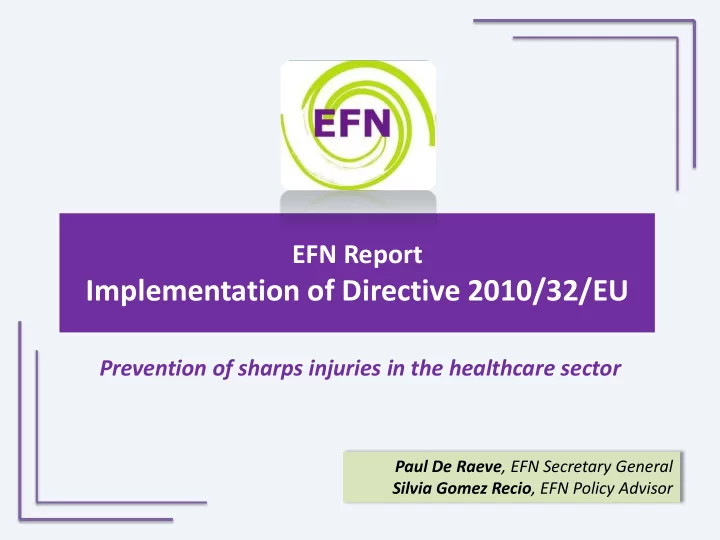

EFN Report Implementation of Directive 2010/32/EU Prevention of sharps injuries in the healthcare sector Paul De Raeve , EFN Secretary General Silvia Gomez Recio , EFN Policy Advisor
Online questionnaire (8 th Oct - 10 th Nov 2013) 4 different parts: - general information - implementation of the Directive at the workplace; 25 questions Dissemination! - equipment and information; - incidents and reporting. EFN members EBN 20 languages OSHA PILOTED among EFN members and stakeholders engaged in the biosafety summit. Checked language, timing, readability, formulation, measurement scales. 6971 replies!!! (28 EU MS covered)
Data analysis Descriptive data analysis (frequency tables & cross table combinations) Cluster analysis is used for the identification of variables to understand what is going on in daily reality when it comes to prevention of sharp injuries and the interconnections between different factors. Directive 2010/32/EU Clauses Questions 5: Risk Assessment 10 and 11 6: Elimination, prevention and protection 7, 8, 15, 16, 17 and 24 7: Information and awareness-raising 3, 4 and 9 8: Education and training 5, 6 and 12 9: Reporting 18 and 19 10: Response and Follow up 20, 21, 22 and 23
Sample 6971 replies Nurses Who are they? (95%) Where do they Hospital work? (77%)
RESULTS Positive impact in the daily practice and clinical environment Practice Professionals improved thanks feel countries to the design have adequate and measures in implementation place of the Directive + Safe mechanism Clear at their disposal responsibility in for certain reporting applications Basic information given at the workplace
RESULTS Lack performance of risk assessments at the workplace Lack of attention to Lack explicit community ban of care and recapping elderly homes - Lack specific Lack of education on awareness sharp injuries campaigns prevention Not all Provision of professionals safety know what to devices is do when a limited sharps injury occurs
Directive Clause 5 - Risk Assessment Lack of risk assessment AT, CZ, DK, IE, NO, UK (60%) regardless More reference workplace colleagues trained in Lack of clinical staff sharps injuries with expertise (55%) prevention in hospital EU Social Funds – LINK NURSE Education capacity workforce development
Directive Clause 6 – Elimination, Prevention and Protection Availability of safety Not suitable equipment (70%) equipment (30%) -BG, Appropriate sharps IS. bins (80%) Recapping NOT YET Personal Protective prohibited (25%) Equipment (96%) Although results are positive: Availability of necessary Personal Protective Equipment shall reach 100%, as health professionals shouldn’t see their risk of exposure to sharp injuries increased due to a lack of protection.
Directive Clause 7 – Information and Awareness raising Basic information provided (78%) - HR, CZ, Not information widely HU, IE, IT, NL, SI available at the workplace (64%) More information in hospital settings. Awareness campaigns Professionals feel Lack of involvement appropriate measures selection devices (58%) are implemented (74%) EU OSHA - Awareness campaigns are needed to inform professionals and patients of the dangers associated with sharp injuries. Importance of workers’ health and safety for European social and economic stability and growth.
Directive Clause 8 – Education and Training Professionals feel they need more instructions on Specific education measures in case of an injury (53%) – CZ, IE, PL. Lack specific education (47%) – IS, NL, PT, SI. Community care and elderly homes NOT specific education. Suppliers DO NOT provide training (76%) Managers should increase the requirements in public procurements to provide the necessary training to use their devices in the most appropriate way. Training requirements from manufactures should be included in tenders. EU Social Funds – Workforce development - Specific training on sharps injuries prevention
Directive Clause 9 & 10 – Reporting, Response and Follow up Professionals suffered Professionals reporting sharps injury (41%) (95%) - Homogenous Knowing a colleague that suffered sharps injury (78%) among all the Not adequate support when countries. suffering the incident (63%) No-blame culture Need to investigate the (73%) causes further (73%) A No-blame culture must reach 100% More action is needed from the employer to investigate the causes of the incident and provide adequate support
Conclusions Risk assessments Specific education - CPD Use of EU SF Specific reference staff: Information LINK Nurse Awareness campaigns Nurses’ involvement in Risk assessment and device selection Supplier responsibility 100% preventive for training measures No-blame culture 100% ban recapping
CONTACT EFN efn@efn.be Clos du Parnasse, 11A 1050 Brussels Belgium Tel.: +32 2 512 74 19 Web: www.efnweb.eu
Recommend
More recommend